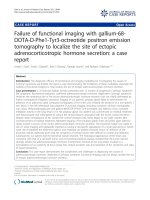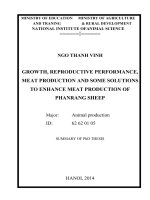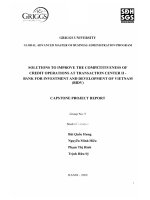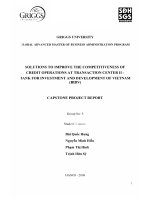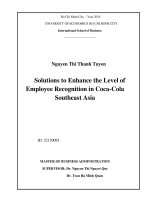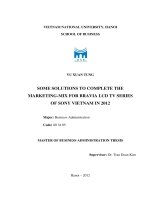Some solutions to rehabilitate the stands of castanopsis boisii hickel et a camus forest in hai duong province
Bạn đang xem bản rút gọn của tài liệu. Xem và tải ngay bản đầy đủ của tài liệu tại đây (7.26 MB, 56 trang )
Some solutions to rehabilitate the stands of Castanopsis boisii Hickel et A. Camus forest
in Hai Duong province
Sturdent: Nguyen Minh Hien; Advisor: Bui The Doi
1
ACKNOWLEDGEMENTS
I would like to express my very great appreciation to Prof. Bui The Doi from Vietnam
Forestry University, my research supervisor, and Dr. Nguyen Tuan Dung, my research cosupervisor, for their enthusiastic encouragement and useful critiques of this research work.
Without his thoughtful, patient guidance through every step of my research, this thesis could
not have been realized
I would like to extend my thanks to Mr. Hoang Duc Luu, the Forest Management
Committee of Hai Duong province for accepting the responsibility of my research in the
location as well as for his useful and constructive recommendations on this project.
Many other people have contributed to the success of this thesis but I would like to
particularly thank my parents and classmates from K57-CTTT for their support. Last but not
least this thesis could have never been complete without the support of Forest Resources and
Environment Management Faculty of Vietnam National University of Forestry always
encouraged me during the entire process of studying and doing research
2
ABSTRACT
This study was conducted to provide several biological characteristics of Castanopsis
boisii such as ability to provide high nutrient food. Several methods have been used to do
field work and data analysis. The basic data analysis indicated that Castanopsis boisii stand
did not only help local people reduce poverty, increase their income and living condition, but
also help improve the beauty and environmental value for regional landscape. According to
the result analyses, I found several solutions to rehabilitate Castanopsis boisii species,
followed by recommendations to effectively and sustainably develop this species in the study
region.
3
TABLE OF CONTENTS
ACKNOWLEDGEMENTS
ABSTRACT
TABLE OF CONTENTS
LIST OF TABLES
LIST OF FIGURES
ACRONYMS
INTRODUCTION ................................................................................................................. 1
CHAPTER 1. LITERATURE REVIEW................................................................................. 3
1.1. In The World ................................................................................................................... 3
1.2. In Vietnam ...................................................................................................................... 3
1.3. Characteristics of Castanopsis boisii ................................................................................ 4
1.3.1. Morphological characteristics ....................................................................................... 4
1.3.2. Ecological characteristics ............................................................................................. 5
CHAPTER 2. STUDY GOAL, OBJECTIVES AND METHODLOGY .................................. 6
2.1. STUDY GOAL AND OBJECTIVES .............................................................................. 6
2.1.1. Goal ............................................................................................................................. 6
2.1.2. Specific objectives........................................................................................................ 6
2.2. METHODLOGY ............................................................................................................ 6
2.2.1. Secondary data collection ............................................................................................. 6
2.2.2. Fieldwork ..................................................................................................................... 6
2.2.3. Interview .................................................................................................................... 12
2.2.4. Data analysis .............................................................................................................. 13
CHAPTER 3. OVERVIEW OF NATURAL AND SOCIAL - ECONOMIC CONDITIONSS
OF STUDY SITE................................................................................................................. 14
4
3.1. NATURAL CONDITION ............................................................................................. 14
3.1.1. Geographical location ................................................................................................. 14
3.1.2. Topography ................................................................................................................ 14
3.1.3. Climate....................................................................................................................... 14
3.1.4. Hydrological .............................................................................................................. 15
3.1.5. Land resources ........................................................................................................... 15
3.2. SOCIAL ECONOMIC CONDITIONS .......................................................................... 15
3.2.1. Population .................................................................................................................. 15
3.2.2. Economy .................................................................................................................... 16
3.2.3. Infrastructure .............................................................................................................. 16
CHAPTER 4. RESULTS AND DISCUSSION..................................................................... 17
4.1. Characteristics of the study site ..................................................................................... 17
4.1.1. Topography ................................................................................................................ 17
4.1.2. Climate....................................................................................................................... 17
4.2. Characteristics of Castanopsis boisii stand ..................................................................... 20
4.2.1. Mature trees ............................................................................................................... 20
4.2.2. Distribution of mature tree layer bases on the height and diameter .............................. 22
4.2.3. Distribution of regenerated trees bases on the height .................................................. 23
4.2.4. Origin of regeneration ................................................................................................ 23
4.2.5. Shrubs vegetation ....................................................................................................... 25
4.3. Castanopsis boisii stand value ....................................................................................... 26
4.3.1. Economic value of Castanopsis boisii forest in study site............................................ 26
4.3.2. Environment value and other value of Castanopsis boisii forest in study site .............. 26
4.4. Some solutions to rehabilitate Castanopsis boisii ........................................................... 27
4.4.1 Adjusting the canopy cover ......................................................................................... 27
5
4.4.2. Adjusting the distribution of regenerated trees ............................................................ 28
4.4.3. Maintaining the soil moisture ..................................................................................... 28
4.4.4. The impact depending on origin of regeneration ......................................................... 29
CHAPTER 5. GENERAL CONCLUSION AND FUTURE STUDY ................................... 30
5.1. Conclusion .................................................................................................................... 30
5.2. Shortcomings ................................................................................................................ 31
5.3. Recommendations ......................................................................................................... 31
REFERENCES
APPENDIX
6
LIST OF TABLES
Table 4.1: Weather data in Chi Linh Hydrometeorology forecast station (2014) ................................18
Table 4.2: Characteristics of mature trees in study site .......................................................................20
Table 4.3: Standard deviation and coefficient of variation of H vn .......................................................21
Table 4.4: Standard deviation and coefficient of variation of D 1.3 .......................................................21
Table 4.5: Distribution of regeneration plant bases on the height .......................................................23
Table 4.6: Origin of regeneration trees in study site ...........................................................................24
Table 4.7: Characteristics of shrub vegetation in study site ................................................................25
Table 4.8: Necessary for coverage in each height levels.....................................................................28
7
LIST OF FIGURES
Figure 4.1: Comparison precipitation and evaporation in Chi Linh 2014 .............................. 19
Figure 4.2: Distribution of mature tree layer bases on the height .......................................... 22
Figure 4.3: Distribution of mature tree layer bases on diameter ............................................ 22
Figure 4.4: The distribution of origin of regenerated trees in study site ................................. 24
8
ACRONYMS
Notation
Description
Hvn
Height
Hunder
Height under canopy
D1.3
Diameter at breast height
D. Crown
Crown diameter
SE
Standard Error
SD
Standard deviation
S
Coefficient of variation
VNUF
Vietnam National University Forestry
BA1
Plot 1 at Bac An commune
BA2
Plot 2 at Bac An commune
HHT1
Plot 1 at Hoang Hoa Tham commune
HHT2
Plot 2 at Hoang Hoa Tham commune
9
INTRODUCTION
Forest is one of the most precious resources in Vietnam, have many benefits such as
disaster prevention, ecological protection, and social economic development support. Forests
and forest land make up to ¾ of the total area of the country [6]. However, the quality and
total area of forests have been declined significantly. The main causes of this decline are due
to forest fires and human activities (i.e. slash and burn cultivation or over exploitation).
Hai Duong is a province in the Red River Delta of northern Vietnam. The natural area
of the province encloses 1661.2 km2, which is ranked 51st in the nation. Hai Duong shares its
borders with six other provinces: Bac Ninh, Bac Giang, Quang Ninh in the north; Hung Yen
in the west; Hai Phong in the East and Thai Ninh in the south. Hai Duong has the tropical
monsoon climate with typically cold winter, potentially hot summer and high humidity
throughout the year. Two types of wind mainly come from the South East and the North East.
The climate is divided into 4 distinct seasons. From early February to early April, Hai Duong
has more rain due to the transition from dry season to rainy season. Rainy season lasts from April
to October. In Hai Duong, the annual average rainfall is from 1,300 to 1,700 mm; the average
temperature is approximately 23.3 oC; and the relative humidity average is around 85 - 87%.
Castanopsis boisii (Dẻ Ăn Quả) belongs to Fagaceae, a native species with many
benefits such as wood for construction and furniture, In addition, it also provides high nutrient
food. In Vietnam, Castanopsis boisii can be typically found in Quang Ninh, Nghe An, Bac
Giang and Hai Duong.
Hai Duong province has 11263.97 ha of forested area, in which protection forest
accounts for 4683.74 ha, production forest accounts for 5036.95 ha, and special-use forest
accounts for 1543.28 ha. Chi Linh commune has the largest area of Castanopsis boisii forest
with more than 2000 ha which is mainly concentrated in Bac An and Hoang Hoa Tham
communes.
1
Forest rehabilitation in Vietnam in general, and Castanopsis boisii rehabilitation in
Hai Duong in particular, have drawn significant concern from the Government, MARD and
local authority. This is mostly due to the economic and ecological values of Castanopsis
boisii. It is one of the forest species that can be growth by high quantity and can provide high
nutrient food. It is also considered as a very promising tree species to support economic
development and forest conservation in many regions in the country.
In fact, local people are more focused on exploiting the benefits from Castanopsis
boisii plantation forest, but have less concern on the future, regeneration and protection of this
species. This leads to the current degradation of Castanopsis boisii forest and therefore,
makes regenerating and developing Castanopsis boisii in forested land a critical issue.
From these reasons, proposed study on “Some solutions to rehabilitate the stands of
Castanopsis boisii Hickel et A. Camus forest in Hai Duong province” has been chosen for
thesis. I do hope to propose appropriate solutions for the mentioned issues
2
CHAPTER 1
LITERATURE REVIEW
1.1. In The World
The study of forest rehabilitation in the world has started early. In 1930, Richards P.W
was the first author to study forest rehabilitation. According to his research regenerated
species in each plot are distributed in cluster for rehabilitation. Scientific research on forest
rehabilitation has been more developed since 1950. For example, both researches from
Barnard (1950) and Smith (1952) in Malaysia, and Lampreht in Venezuela (1954) indicated
the need of using the existing vegetation with different side conditions to maintain the natural
regeneration and additional planting to restore the forest structure similar to be the original
structure.[2]. While other researches by Weidelt (1968) on the upland abandoned forests in
Brazil indicated the development of secondary forests would move towards the initial
condition of primary forest in the number of species and species composition.[8].
In 1975, Whitimore studied on development of secondary vegetation and found that
the time needed to regenerate forests by seedling to reach to the initial state can take hundreds
of years. In 1996, Fedmaner found that the main factors affecting the process of forest
rehabilitation are site conditions, component types and genetic resources.
1.2. In Vietnam
In Vietnam, study on forest rehabilitation started since 1950s. This study area
continued to grow in 1961. During the 1990s, we saw more in depth studies on forest
rehabilitation and forest succession in Vietnam.
In 1993, for solutions regarding rehabilitation of forest ecosystems exposed to Agent
Orange in the Southern part of Vietnam, Thai Van Trung concluded that, it was needed to go
through two steps for rehabilitating those forests. Planting species which have the ability to
3
synthesize natural nitrogen, and Cutting those planted species to regenerate by other species
with more value and benefits.[9]
Nguyen Ngoc Lung (1995) stated on his research that, effective rehabilitation
depended on many factors such as site conditions, characteristics of that species and social
economic conditions of that region.[5]
Almost all studies have focused on understanding the law of succession process of
forest rehabilitation. These results serve as scientific basis for solutions of
forest
rehabilitation.
1.3. Characteristics of Castanopsis boisii
1.3.1. Morphological characteristics
Castanopsis boisii has the average height is 10 – 15 m and average diameter range of
30 – 40 cm. This species has straight and round stem. Bark is grey while, thick and fissure
with some small vertical cracks. Young braches are smooth, while patches and long. This
species has mixed root system with tap roots and lateral roots are both well developed. Leaves
are simple and alternate which are 9 – 16 cm in length and 4 – 7 cm in width. Leaf blade is
narrowly elliptic to ovate – oblong or lanceolate – elliptic. Head of leaf is slightly pointed,
asymmetric leaf blade. Adaxial surface is dark green and smooth, abaxial surface has scales
with color in light pink. Venation pinnate, lateral veins 10 – 14 pairs. Petiole thin, 1.5 – 1.8
cm in length and stipule present.
Flowers are unisexual catkins. Male inflorescences are very slender, 5 – 12 cm in
length, filament long, pedicel thin and hair, anther round. Female inflorescences have hair,
styles 3.
Fruits are nuts within a cup. Each fruit usually has a single seed, dehiscent when
mature. Seed is brown, hard shell and covered with yellowish hair, 1.2 cm in height, 0.7-1.0
cm in diameter. The fruit is a calybium, the kind of encased nut typical of Fagaceae. The
4
calybium resembles a pointed acorn, the cupule is hard like that of beechnuts and spiny like
that of chestnuts. Three thickened reidges run the length of the calybium’s shell.
1.3.2. Ecological characteristics
Castanopsis boisii flowers from September till November, fruit ripes from August to
October of the following year, or one ripening in every two years. (Le Mong Chan, 2000)
(Nguyen Tien Ban, 2003) [4]. According to Dang Ngoc Anh (1996), Castanopsis boisii starts
flowering and seed harvesting in the ages of 4 to 5, age for stable seed harvesting starts from the
age of 10 and lasts for 40-50 years, the more productive stage is between 20- 35 years old [1].
Castanopsis boisii is evergreen tree, lucipetal, growth and develop well on sandstone.
This species naturally grow into populations in the hillside and foothills. Castanopsis boisii
regenerates strongly on bare soil or under woodlands. It is a pioneer tree species after clear cut
(Le Mong Chan 2000; Nguyen Tien Ban 2003) [7].
5
CHAPTER 2
STUDY GOAL, OBJECTIVES AND METHODLOGY
2.1. STUDY GOAL AND OBJECTIVES
2.1.1. Goal
Contributing some solutions to rehabilitate Castanopsis boisii in Hai Duong province
for sustainable forest development.
2.1.2. Specific objectives
Determining the characteristic of stands of Castanopsis boisii Hickel et A. Camus.
Purposing some solutions to rehabilitate Castanopsis boisii in the study site.
2.2. METHODLOGY
2.2.1. Secondary data collection
Inheriting data from precious studies on natural condition, climate, hydrology, soil,
natural resources, socio-economic condition of the study site. There are very useful
information to suggest solutions for Castanopsis boisii rehabilitation.
2.2.2. Fieldwork
2.2.2.1. Investigating mature trees, shrubs and regenerated trees
In Hoang Hoa Tham and Bac An communes, Setting up 4 sample plots with plot size
of 1000 m2 (40 m in length and 25 m in width). In each sample plot, establishing 5 sub-plots;
4 sub-plots at the 4 corners and 1 sub-plot at the center. The shape of sub-plot is square (2 m x
2 m).
6
40m
25m
2m
2m
In each sample plot, height, under canopy height, canopy diameter, and diameter at
breast height are measured. In each sub-plot, determine shrubs and the amount of regenerated
plants with have the tree height from 30 cm to 1.3 m are examined. Regenerated plants from
seed or bud are also examined.
Investigating mature trees:
- Measuring height: using the Blume-Leiss to measure tree height. This device
measures the elevation angle between the operator and measured points. The person in charge
must stand still in a location with 15, 20, 30 or 40 meters horizontal distance from the base of
a vertical tree where the required points on the tree can be seen.
- Measuring diameter: using calipers to measure tree diameter. The fixed arm is
placed along one side of the tree, usually at 1.3m from the tree base. The moveable arm is
then placed flush against the other side of the tree and the scale is read directly. The calipers
must be located perpendicular to the stem axis.
- Measuring crown diameter: using fiberglass tape to measure crown diameter by
sketching the tape to both ends of the crown and read the value, by N-S and E-W axis.
- Investigating growth quality by observation.
7
Investigating shrub vegetation:
- Investigating shrub vegetation in each transect line by establish plots with area 4
m2 (2m x 2m).
- The height of shrub vegetation is measured by fiberglass tape
Investigating regenerated trees:
- Measuring height: Using fiberglass tape with accuracy of 1 cm
- Measuring diameter: Using fiberglass tape. The tape is wrapped around the tree to
measure circumference. This value is divided by PI (3.1415…) to estimate diameter.
- Origin of regeneration: Observe stem, if the stem is straight then it is the indicator
of regeneration from seed. If the stem is curve then it is the indicator of regeneration from
bud.
8
Table 01. Tree data collection
Location: ..............................
Inventory date: .....................
Forest type:...........................
Surveyor:..............................
No.
Name
H
Hunder
D1.3
Crown D.
Quality
Note
1
Table 02. Shrubs investigation
Location:
Forest type: ......................................
Regeneration plot ID: .......................
Surveyor:
Quality
No.
Name
Height(cm)
Note
Good
1
9
Medium
Bad
Table 03. Regeneration investigation
Location:
Forest type: ......................................
Regeneration plot ID: .......................
Surveyor:
Height(m)
No.
Origin
Name
Quality
<0,5 m
0.5-1 m
1-2 m
2-3 m
>3 m
B
S
1
2.2.2.2. Investigating climate condition: determining temperature, moisture, rainfall
The study took the weather data from Chi Linh Hydrometeorology forecast station
10
11
Total
sunny hour
Total
thunderstorm day
(mm)
Evaporation
(mm)
Precipitation
humidity (%)
Average
criteria
temperature (oC)
Annual
Dec
Nov
Oct
Sep
Aug
Jul
Jun
May
Apr
Mar
Feb
Jan
Weather
Average
2.2.2.3. Investigating the lighting conditions of regeneration plant through canopy
coverage and statistic to process data result.
Investigating canopy coverage based on 100 points in the plot. Estimated value is
either 0; 0.5; or 1. Canopy cover is the mean value of 100 point. Measuring the coverage of
shrubs in each sub-plot by estimating the percentage of area occupied by the shrubs compared
to the total area of the cell types.
Table 05. Canopy cover
Location:
Forest type: ......................................
Regeneration plot ID: .......................
Surveyor:
No.
Canopy cover
Coverage of shrubs
Note
1
2.2.3. Interview
Interviewing to have information about Castanopsis boisii forest such as how they are
managed, harvested, and also the conditions to plant this species.
Interview method includes discussions and open questionnaires.
The list of questions:
Name: ............................
Age: ...............................
Address: .........................
Jobs: ...............................
12
1. Have you ever planted Castanopsis boisii specie?
2. Do you know about the condition to plant Castanopsis boisii specie?
3. Is there any factor that effect to the growth rate of Castanopsis boisii specie?
4. How much does it cost for 1 kg seeds?
5. How many kg seeds you can harvest per year?
6. Do governments support people to plant Castanopsis boisii specie?
7. How long is this specie harvested after planting?
8. Do people in here care about this specie?
9. Do you know about the current state of Castanopsis boisii specie?
10. Besides harvesting Castanopsis boisii, what do you do to increase income?
11. If you are supported by government, do you want to plant this species as your main
source of income?
2.2.4. Data analysis
Using EXCEL software to analyze and measure data.
13
CHAPTER 3
OVERVIEW OF NATURAL AND SOCIAL - ECONOMIC CONDITIONSS OF
STUDY SITE
3.1. NATURAL CONDITION
3.1.1. Geographical location
Chi Linh town is located in the Northeast of Hai Duong province. The geographical
coordinates:
-
From 20 o 02 ’ to 21 o 15 ’ N
-
From 106 o 17 ’ to 106 o 38 ’ E
Chi Linh shares it border with Nam Sach and Kinh Mon district in the south, Luc Nam
district (Bac Giang province) in the north, Que Vo and Gia Binh district (Bac Ninh province)
in the west, Dong Trieu district (Quang Ninh province) in the East. Chi Linh has 20
administrative units, including 8 wards and 12 communes. The total area is 282 km2.
With these geographical location features, the town has advantages in business,
agriculture and forestry production.
3.1.2. Topography
Chi Linh has varied terrain, including mountains, hills and delta. North and northeast
of the town is mountainous, belonging to the bow-shaped Dong Trieu’s mountain range.
There are hills along the High way 18 with the height of 50 – 60 m, the slope of 10 – 15o. They
are advantages for economic development of agriculture and forestry with the model hill garden.
The south of High way 18 encloses a delta area with relatively flat terrain declining to the south.
3.1.3. Climate
Chi Linh is located in the tropical monsoon region. It is divided into 2 distinct seasons.
Rainy season spans from May to October, while dry season spans from November to April of
the next year.
14
The annual average temperature is 23oC. The months which have the highest
temperature are June and July (36oC to 38oC). January and February have the lowest
temperature (10oC to 12oC).
The annual rainfall is 1,480 mm, which mainly concentrated in June, July and August
with 78% of the annual rainfall. The average humidity is 85% with the lowest humidity at
33,5% in November. The month which has highest humidity is April.
Two main wind directions are north-eastern monsoon and southeastern. North-eastern
wind is more harmful to agricultural products and forestry products.
In general, Chi Linh’s climate is suitable for planting agroforestry species, including
Castanopsis boisii.
3.1.4. Hydrological
Chi Linh is influenced by the tides of Pha Lai river and Thuong river. The average
water current is 286 m3/s. The lowest is 181 m3/s. This town has 33 natural dams and a large
ground water reserve that can enough to support people’s lives and production activities.
3.1.5. Land resources
The total area of Chi Linh is 28.202,8 ha (01/01/2011). Including:
Agriculture land is 20.700,77 ha, accounting for 73.4 % of the total area. Of those,
51.2 %, are for agriculture product, 46% are forestry and 2.8% are for aquaculture.
Non-agriculture land is 7.360,2 ha, accounting for 26.1 % of the total area.
Unused land is 141,8 ha, accounting for 0.5 % of total area.
3.2. SOCIAL ECONOMIC CONDITIONS
3.2.1. Population
The population of Chi Linh town as of 2015 is 175.000 people, with a density of 584
persons per km2 and uneven distribution. The ethnic groups identified in the town is 15, mostly
Kinh make up 95.1 % and other ethnic is Man, Hoa, Kho Me, Tay, Nung, San Diu, ect.
15
The town has 79.167 labors, accounting for 55 % of total population. Labor for
agroforestry and fishery make up 75.4 % of total labor, labor for construction industry make
up 12.5 % of total labor and labor for service make up 12.1 % of total labor.
3.2.2. Economy
GDP of the town reaches 22.2 million VND / person / year. Agroforestry and fishery
make up 23 %, construction industry make up 45.6 % and service make up 31.4 %.
Cultural, information and sport activities, continue to grow. Business training,
employment, social security achieve many results, the poverty rate has dropped to 3.5%.
Political security, public order and safety is maintained in the province, social evils are
reduced. Inspection efforts, resolving complaints and denunciations and judicial reform have
made progress.
3.2.3. Infrastructure
Electric power system is coverage whole the town, 100% households used electric for
living and production. Irrigation system is relatively complete, well plans on flood, storm
prevention. Transportation system is strengthened and the unqualified, high frequency of
accident roads are improved not disturb traveling of people.
16

